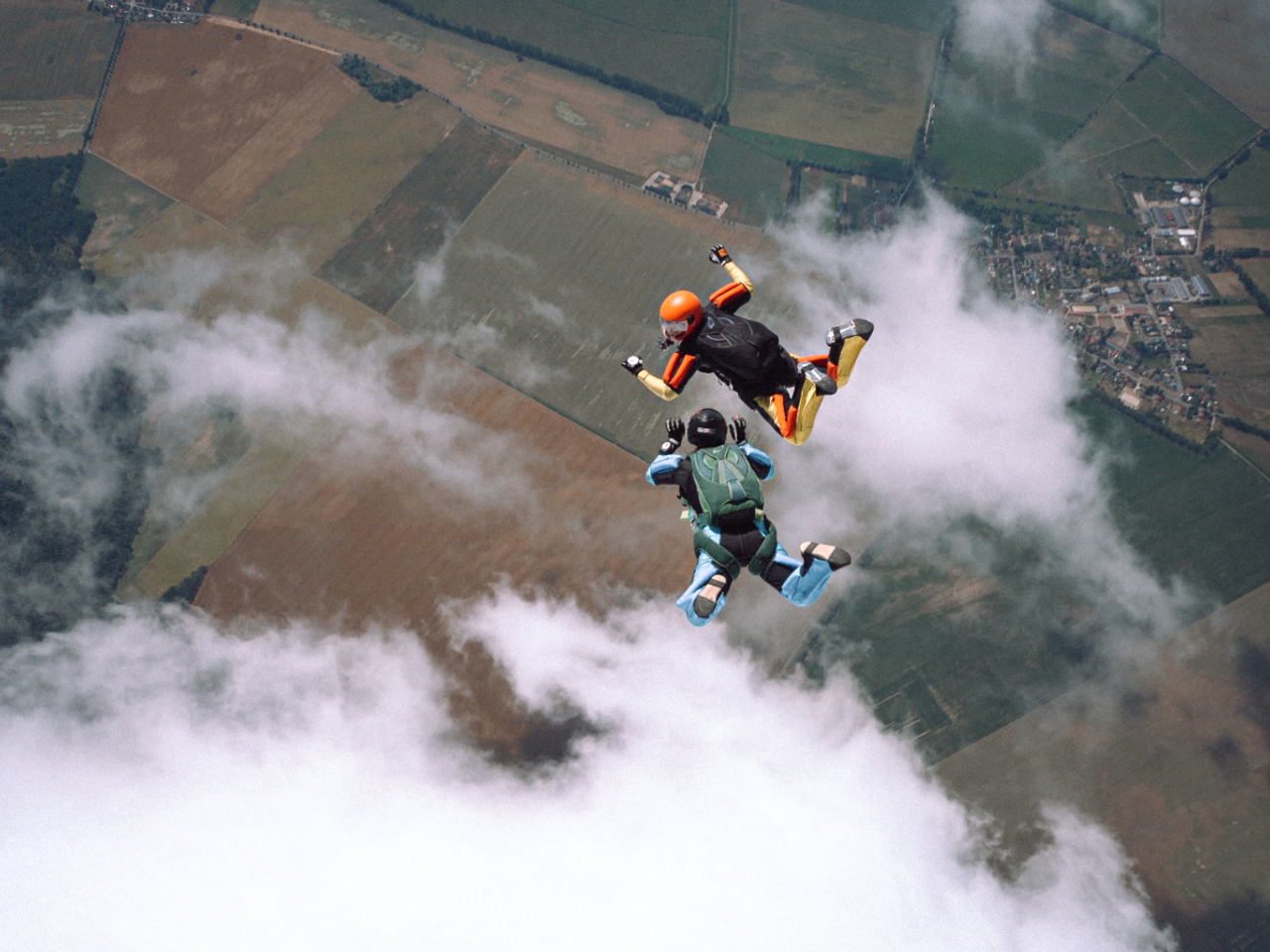
Skydiving is a thrilling sport that many people have somewhere on their bucket list. It has recently become more and more popular by being depicted in movies, as an international sport, and through the advent of indoor skydiving arenas that reduce the cost and fear factor. [1]
However, skydiving in its original, classic form requires having access to a plane, parachute, and above all else, good weather conditions.
Weather conditions like wind speed, and cloud cover have more to do with whether a skydive goes ahead than you might think. For instance, if the ground can’t be seen from the airplane due to cloud coverage, the dive will not go ahead. This is because GPS is unreliable, and it’s essential to be 100% certain of where you’ll land after jumping. [2]
High winds might not sound so bad when you’re safe on the ground, but they can cause parachutes to be blown off course or even impact their unfolding. Rain also stops a skydive, as careening through the sky at high speeds into thousands of tiny little obstacles is absolutely no fun. [2]
So what are good skydiving weather conditions? And how can you be sure there is going to be good skydiving weather? We’ll explore these concepts throughout the rest of the article as well as discuss the utility of Sonuby’s Skydiving Report which provides skydiving weather forecasts specifically designed for planning your next jump.
In 2021 alone, nearly 3.57 million jumps were completed in the United States!
Ideal wind conditions are typically under 22 km/h (14 mph) for beginners, with consistent direction. Experienced skydivers may handle speeds up to 32 km/h (20 mph). Wind conditions vary at different altitudes, making forecasts essential.
Temperature drops approximately 2°C (3.5°F) for every 300 meters (1,000 feet) of altitude. Even on warm days, it gets significantly colder at jump altitude (3,000+ meters or 10,000+ feet). Most skydivers prefer ground temperatures of 23-30°C (75-85°F) for comfort throughout the jump.
Clear visibility is mandatory for skydiving—you need to see the ground clearly from the aircraft. FAA regulations often require at least 5 kilometers (3 miles) of visibility and being clear of clouds for legal jumps.
Spring and summer generally offer the best skydiving conditions with clearer skies and moderate temperatures. However, any season can provide good jumping weather depending on your location, with Sonuby's Skydiving Weather Report helping you find ideal conditions year-round.
Sonuby Weather is specifically designed for skydivers, offering altitude-specific forecasts that standard weather apps don't provide. It displays wind speeds at different altitudes, cloud coverage layers, and temperature gradients—crucial information for planning safe jumps that generic weather apps typically lack.
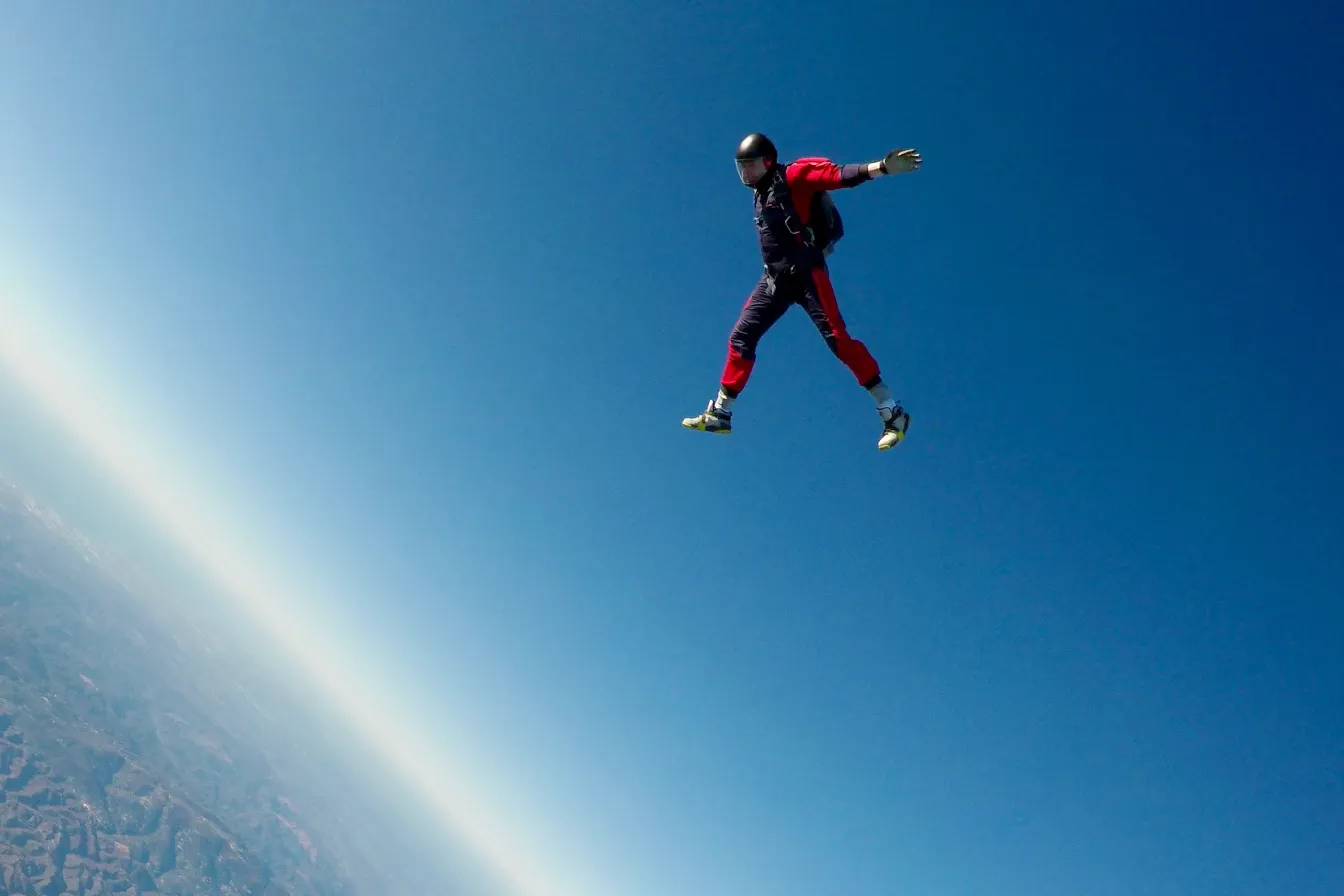
Photo by Kamil Pietrzak
One of the most critical factors to consider when skydiving is the wind. Wind affects all aspects of a skydive, from the initial plummet from the airplane to the eventual landing. It’s important to consider how fast you’ll be moving toward the ground in relation to the wind, to make sure that you aren’t being pushed around by the wind when you land. [3]
In addition, having a stable wind direction helps to plan the jump, letting you know which way you’ll be facing and which way to land. This helps to avoid the parachute dragging you around once you land and helps prevent accidents during the landing process. [3]
Most skydives occur from approximately 3 kilometers (10,000 feet) above surface.
Obviously temperature is important, and if you’ve ever felt windchill on a mountain, you’ll know exactly why. The higher you get, the colder the wind is, so even if the temperature is only a bit chilly on the ground, you’ll likely be an icicle by the time you get down there after jumping out of an airplane high in the sky. [3]
The exact ideal temperature is, in part, up to whatever you’re able to tolerate. That being said, most people jump in temperatures around 23–30°C (75–85°F). [4] Your best bet is to bundle up warm. After all, depending on the altitude at which you’ll exit the plane you’ll be flying through the air for several minutes. You wouldn’t want cold hands to distract you from all the beautiful sights you’ll be soaking in.
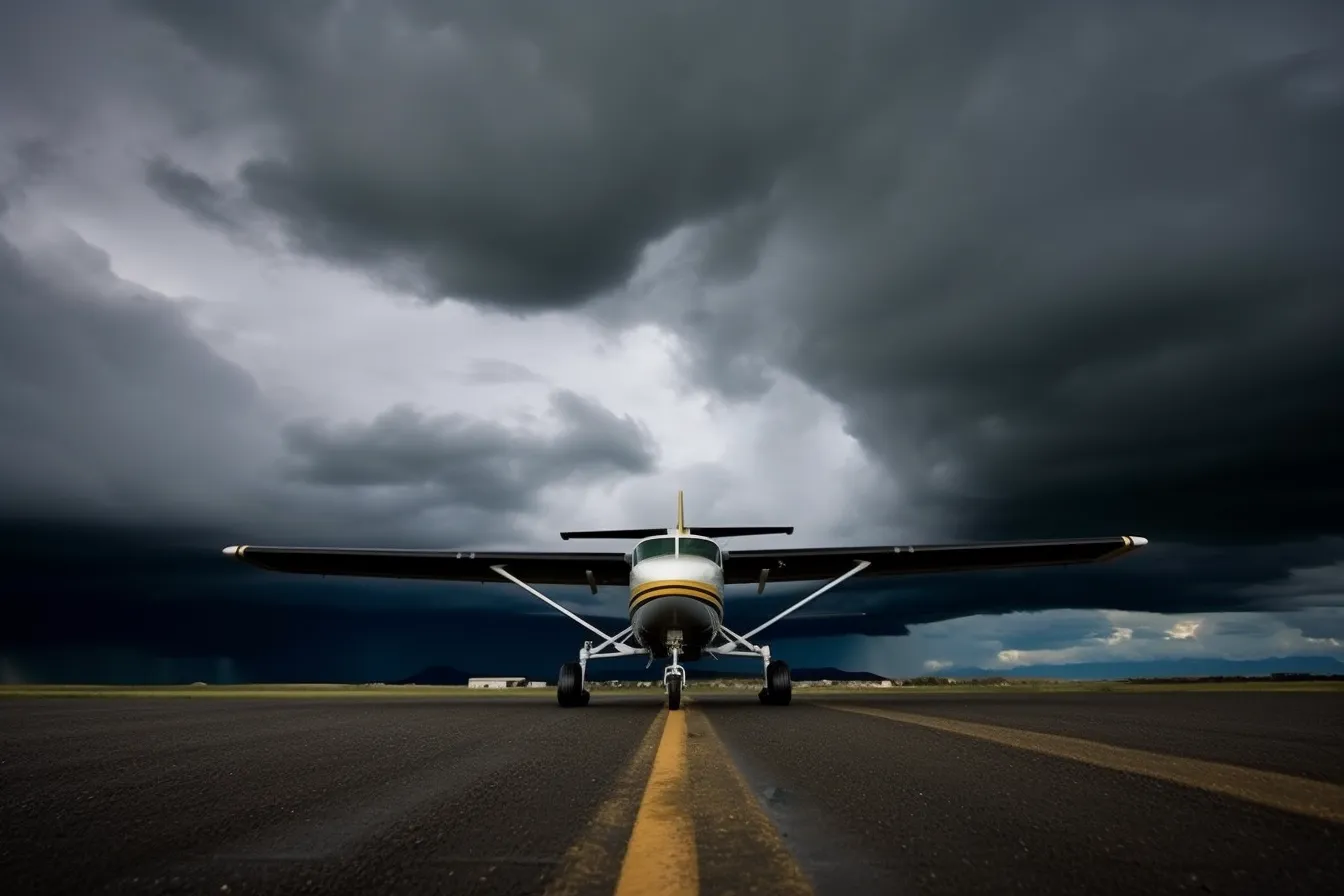 Safe jumps would not be possible in this weather.
Safe jumps would not be possible in this weather.
Like we mentioned earlier, visibility is an important factor for planning and executing a jump. You can’t jump if you have poor skydiving weather conditions. If the ground isn’t visible, for all you know you could be jumping right into the middle of the ocean or a mall parking lot. Without the ability to look, you won’t be leaving the plane. [3]
The amount of moisture in the air is essential to knowing whether or not a jump is going to go ahead. This is for a few reasons, including comfort and safety.
As we explained earlier, any rain in the air can create obstacles that you fly into as you descend throughout the dive. In fact, you’ll be hitting the rain droplets while you’re going around 195 kilometers per hour (120 miles per hour) or more, which would obviously be quite painful. Skydiving in the rain isn’t just a bad idea, it’s also not allowed due to safety regulations. Not only do you have the pain of impacting drops on the way down, the rain obscures the ground, which, as we mentioned earlier, prevents the jump from happening. [3]
In case you wanted to throw all caution aside and jump in the rain regardless of the dangers and rules against it, you should know that the canopy of the parachute can also be impacted. Extra water in the parachute absorbed over the fall will change the landing. [4]
The seasons can also impact skydiving weather conditions. Generally, spring and summer are the best seasons for skydiving as they have the least cloud cover and fewer rainy days. Winter is often too cold and autumn is often foggy or overcast.
By increasing their surface area in a belly-to-earth orientation, skydivers can slow their fall rate tremendously. But if they were to change their orientation to have our heads toward the ground, thus dramatically reducing their surface area, they can reach speeds of up to 320 km/h (200 mph)!
Skydiving requires good weather conditions in order to be safe. Adverse weather conditions like thunderstorms or strong winds are not safe for skydiving as they can impact the parachute function, the ability to land, and personal safety during the dive.
No one wants to think about potential emergencies when planning a skydiving expedition, but it’s important to plan ahead. One of the likeliest issues to come up is a sudden change in weather conditions.
There’s very little you can do when weather changes create an emergency during your skydive. Making sure that all gear, including the reserve parachute, is up to date and functional is important before take off. This is the best way to keep you as safe as possible if adverse weather hits during your jump.
The most likely time that weather will cause an accident is at landing. This is particularly true if winds change direction or speed unexpectedly. The best thing for this scenario is to have already practiced landing in a variety of conditions so you know what to do.
Indoor skydiving arenas can also be useful for learning, practicing, or maintaining skills under specific conditions.
The most recent skydiving data from the 2021 USPA Safety Report recorded 10 fatal skydiving jumps out of the approximately 3.57 million skydives that were made that year.
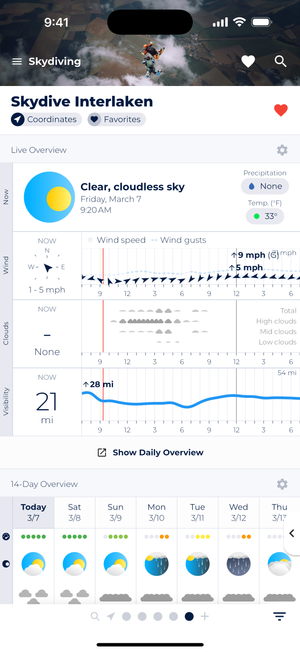
Quickly check if conditions are good for your next jump with the Live Overview and the 14-Day Overview.
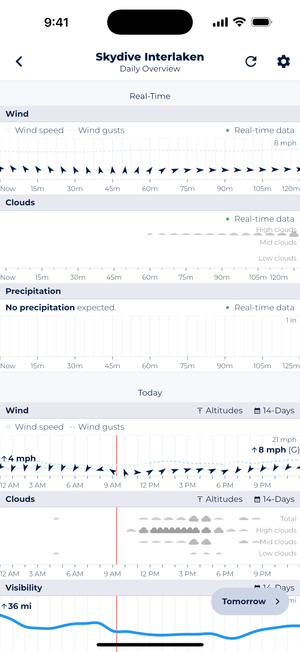
Daily Overview allows you to drill down to specific days and review conditions for specific days.
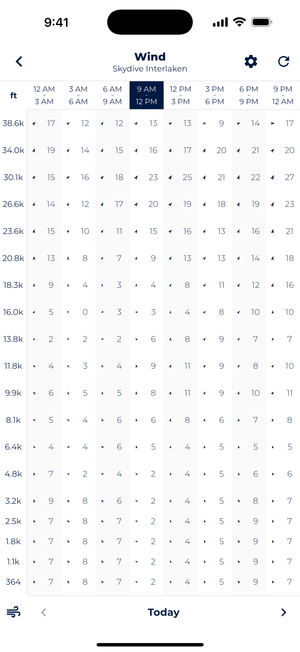
Altitude forecasts for wind, clouds, and temperature allow you to further prepare for your jumps.
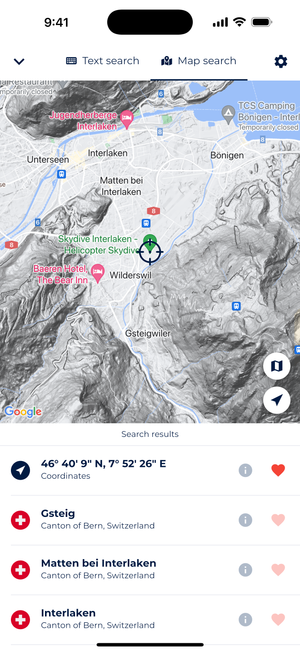
Map Search allows you to point to any drop zone on the face of the earth and see forecasts for it.
Sonuby is the only weather forecasting app that has a specific Skydiving Weather Report. Among the usual forecastable features like wind speed, direction, and likelihood of precipitation at ground level, it features an altitude forecast.
This altitude forecast offers a visual cross section of the sky above a selected location and shows cloud coverage, wind speeds and temperatures for different altitudes. With just a quick view you’ll know whether the conditions at a certain point in time are favorable for your next jump.
References:
[1] www.skydivecoastalcarolinas.com
[2] www.longislandskydiving.com